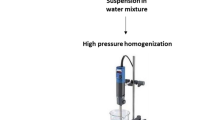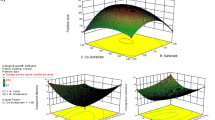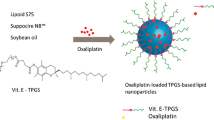Abstract
Purpose
In this study, the oral nanotherapeutic approach of 5-fluorouracil solid lipid nanoparticles (5-FU SLNs) for the synergistic treatment of colorectal cancer in preclinical DMH rat model is studied.
Method
5-Fluorouracil solid lipid nanoparticles with solvent evaporation emulsification method by using different ratios of polymer and surfactant.
Result
5-FU SLNs with chitosan and poloxamer 407 ratio of 2.4:0.1 has shown better particle size (147.9 ± 1.48 nm) with entrapment efficiency 90.60 ± 0.01% and loading content 3.40 ± 0.03%. In vitro, drug release studies were done by using simulated fluids at various pHs (1.2, 4.5, 7.5, and 7.0) to mimic the GIT tract and achieve 85.16 ± 0.26% at 24 h in a sustained manner. In the current investigation, treatment with 5-FU SLNs increased levels of SOD, CAT, and GSH in the colonic tissue which were considerably DMH-treated rats having lower level. It should be highlighted that the 5-FU SLNs anticancer activity on colorectal was superior over the course of the study, utilizing an in vivo model. Colonic tumour incidence, speed, size, and multiplicity, as well as the number of ACFs, have all decreased.
Conclusion
Collectively, based on the chitosan-TPP platform, these results suggest that both 5-fluorouracil solid lipid nanoparticles confirmed in vitro and in vivo has shown to provide a promising oral delivery for colorectal cancer.
Graphic Abstract









Similar content being viewed by others
Data Availability
Data included in article/supplementary material/referenced in article.
References
Siegel RL, et al. Colorectal cancer incidence patterns in the United States, 1974–2013. JNCI: J Natl Cancer Inst. 2017;109(8).
Zalewski B. Levels of v5 and v6 CD44 splice variants in serum of patients with colorectal cancer are not correlated with pT stage, histopathological grade of malignancy and clinical features. World J Gastroenterol. 2004;10(4):583.
Lage H. An overview of cancer multidrug resistance: a still unsolved problem. Cell Mol Life Sci. 2008;65(20):3145.
Sastre RL, et al. Preparation and characterization of 5-fluorouracil-loaded poly (ϵ-caprolactone) microspheres for drug administration. Drug Dev Res. 2004;63(2):41–53.
Zhang N, et al. 5-Fluorouracil: mechanisms of resistance and reversal strategies. Molecules. 2008;13(8):1551–69.
Ramanathan RK, et al. Safety and toxicity analysis of oxaliplatin combined with fluorouracil or as a single agent in patients with previously treated advanced colorectal cancer. J Clin Oncol. 2003;21(15):2904–11.
Haggar FA, Boushey RP. Colorectal cancer epidemiology: incidence, mortality, survival, and risk factors. Clin Colon Rectal Surg. 2009;22(4):191.
Longey D, Harkin D, Jonson PG. 5-Fluorouracil—mechanisms of action and clinical strategies. Nat Rev Cancer. 2003;3:330–8.
Sun X, et al. pH-sensitive ZnO/carboxymethyl cellulose/chitosan bio-nanocomposite beads for colon-specific release of 5-fluorouracil. Int J Biol Macromol. 2019;128:468–79.
Udofot O, Affram K, E.A. Bridg'ette Israel. Cytotoxicity of 5-fluorouracil-loaded pH-sensitive liposomal nanoparticles in colorectal cancer cell lines. Integrative cancer science and therapeutics. 2015;5):245.
Gokare P, et al. P53 represses pyrimidine catabolic gene dihydropyrimidine dehydrogenase (DPYD) expression in response to thymidylate synthase (TS) targeting. Sci Rep. 2017;7(1):1–12.
Minchinton AI, Tannock IF. Drug penetration in solid tumours. Nat Rev Cancer. 2006;6(8):583–92.
Li P, et al. Development of chitosan nanoparticles as drug delivery systems for 5-fluorouracil and leucovorin blends. Carbohyd Polym. 2011;85(3):698–704.
Şanlı O, et al. Preparation of magnetite-chitosan/methylcellulose nanospheres by entrapment and adsorption techniques for targeting the anti-cancer drug 5-fluorouracil. Artif Cell Nanomed Biotechnol. 2016;44(3):950–9.
Ferrari M. Cancer nanotechnology: opportunities and challenges. Nat Rev Cancer. 2005;5(3):161–71.
Chen G, Gong R. Study on fluorouracil–chitosan nanoparticle preparation and its antitumor effect. Saudi Pharm J. 2016;24(3):250–3.
Wang X, et al. Advances of cancer therapy by nanotechnology. Cancer Research and Treatment: Official Journal of Korean Cancer Association. 2009;41(1):1.
Yousefpour P, et al. Polyanionic carbohydrate doxorubicin–dextran nanocomplex as a delivery system for anticancer drugs: in vitro analysis and evaluations. Int J Nanomed. 2011;6:1487.
Katas H, Alpar HO. Development and characterisation of chitosan nanoparticles for siRNA delivery. J Control Release. 2006;115(2):216–25.
Gulbake A, Jain SK. Chitosan: a potential polymer for colon-specific drug delivery system. Expert Opin Drug Deliv. 2012;9(6):713–29.
Hosseini SF, et al. Two-step method for encapsulation of oregano essential oil in chitosan nanoparticles: preparation, characterization and in vitro release study. Carbohyd Polym. 2013;95(1):50–6.
Talasaz AH, et al. In situ gel forming systems of poloxamer 407 and hydroxypropyl cellulose or hydroxypropyl methyl cellulose mixtures for controlled delivery of vancomycin. J Appl Polym Sci. 2008;109(4):2369–74.
Cuenca AG, et al. Emerging implications of nanotechnology on cancer diagnostics and therapeutics. Cancer. 2006;107(3):459–66.
García-Pinel B, et al. Lipid-based nanoparticles: application and recent advances in cancer treatment. Nanomaterials. 2019;9(4):638.
Smith T, et al. Application of smart solid lipid nanoparticles to enhance the efficacy of 5-fluorouracil in the treatment of colorectal cancer. Sci Rep. 2020;10(1):1–14.
Kuppusamy P, et al. In vitro anticancer activity of Au, Ag nanoparticles synthesized using Commelina nudiflora L. aqueous extract against HCT-116 colon cancer cells. Biol Trace Elem Res. 2016;173(2):297–305.
Lim EK, et al. pH-triggered drug-releasing magnetic nanoparticles for cancer therapy guided by molecular imaging by MRI. Adv Mater. 2011;23(21):2436–42.
Sun L, et al. Preparation of 5-fluorouracil-loaded chitosan nanoparticles and study of the sustained release in vitro and in vivo. Asian J Pharma Sci. 2017;12(5):418–23.
Rokhade AP, et al. Novel hydrogel microspheres of chitosan and pluronic F-127 for controlled release of 5-fluorouracil. J Microencapsul. 2007;24(3):274–88.
Trickler WJ, et al. Chitosan and glyceryl monooleate nanostructures containing gemcitabine: potential delivery system for pancreatic cancer treatment. AAPS PharmSciTech. 2010;11(1):392–401.
Pandit AA, Dash AK. Surface-modified solid lipid nanoparticulate formulation for ifosfamide: development and characterization. Nanomedicine. 2011;6(8):1397–412.
Nagarwal RC, et al. Chitosan nanoparticles of 5-fluorouracil for ophthalmic delivery: characterization, in-vitro and in-vivo study. Chem Pharm Bull. 2011;59(2):272–8.
Mohammed MA, et al. An overview of chitosan nanoparticles and its application in non-parenteral drug delivery. Pharmaceutics. 2017;9(4):53.
Wang S, et al. Degradation and 5-fluorouracil release behavior in vitro of polycaprolactone/poly (ethylene oxide)/polylactide tri-component copolymer† 1. Polym Adv Technol. 2001;12(3–4):253–8.
Agarwal M, et al. Preparation of chitosan nanoparticles and their in-vitro characterization. Int J Life Sci Res. 2018;4(2):1713–20.
Tığlı Aydın RS, Pulat M. 5-Fluorouracil encapsulated chitosan nanoparticles for pH-stimulated drug delivery: evaluation of controlled release kinetics. J Nanomater. 2012;2012.
Freitas C, Müller R. Correlation between long-term stability of solid lipid nanoparticles (SLN™) and crystallinity of the lipid phase Eur J Pharm Biopharm. 1999;47(2):125–32.
Davda J, Labhasetwar V. Characterization of nanoparticle uptake by endothelial cells. Int J Pharm. 2002;233(1–2):51–9.
Balaji C, Muthukumaran J, Nalini N. Chemopreventive effect of sinapic acid on 1, 2-dimethylhydrazine-induced experimental rat colon carcinogenesis. Hum Exp Toxicol. 2014;33(12):1253–68.
Chari KY, Polu PR, Shenoy RR. An appraisal of pumpkin seed extract in 1, 2-dimethylhydrazine induced colon cancer in wistar rats. J Toxicol. 2018.
Dhawale S, Bankar A, Patro M. Formulation and evaluation porous microspheres of 5-fluorouracil for colon targeting. Int J Pharm Tech Res. 2010;2(2):1112–8.
Prasad VG, et al. Sambar, an Indian dish prevents the development of dimethyl hydrazine–induced colon cancer: a preclinical study. Pharmacogn Mag. 2016;12(Suppl 4):S441.
Zhao R, Michor F. Patterns of proliferative activity in the colonic crypt determine crypt stability and rates of somatic evolution. PLoS Comput Biol. 2013;9(6):e1003082.
Sedlak J, Lindsay RH. Estimation of total, protein-bound, and nonprotein sulfhydryl groups in tissue with Ellman’s reagent. Anal Biochem. 1968;25:192–205.
Marklund S. Extracellular superoxide dismutase and other superoxide dismutase isozymes in tissues from nine mammalian species. Biochem J. 1984;266:213–9.
Sinha AK. Colorimetric assay of catalase. Anal Biochem. 1972;47(2):389–94.
Yang Z, et al. Chitosan coated vancomycin hydrochloride liposomes: characterizations and evaluation. Int J Pharm. 2015;495(1):508–15.
Zhao GD, et al. Development and characterisation of a novel chitosan-coated antioxidant liposome containing both coenzyme Q10 and alpha-lipoic acid. J Microencapsul. 2015;32(2):157–65.
Chung HJ, et al. Synthesis and characterization of Pluronic® grafted chitosan copolymer as a novel injectable biomaterial. Curr Appl Phys. 2005;5(5):485–8.
Park SN, Jo NR, Jeon SH. Chitosan-coated liposomes for enhanced skin permeation of resveratrol. J Ind Eng Chem. 2014;20(4):1481–5.
Hadjiioannou TP, et al. Quantitative calculations in pharmaceutical practice and research. 1993: VCH New York.
Bourne D. Pharmacokinetics In: Modern pharmaceutics; Banker, GS, Rhodes, CT, Eds. Marcel Dekker Inc: New York, 2002.
Higuchi T. Mechanism of sustained‐action medication. Theoretical analysis of rate of release of solid drugs dispersed in solid matrices. J Pharma Sci. 1963;52(12):1145–9.
Hixson A, Crowell J. Dependence of reaction velocity upon surface and agitation. Ind Eng Chem. 1931;23(8):923–31.
Singhvi G, Singh M. In-vitro drug release characterization models. Int J Pharm Stud Res. 2011;2(1):77–84.
Ponnuraj R, et al. Formulation and characterization of epigallocatechin gallate nanoparticles. Am J Pharm Res. 2015;5:387–99.
Guo Y, Shalaev E, Smith S. Physical stability of pharmaceutical formulations: solid-state characterization of amorphous dispersions. TrAC, Trends Anal Chem. 2013;49:137–44.
Rahman Z, et al. In-vivo evaluation in rats of colon-specific microspheres containing 5-fluorouracil. J Pharm Pharmacol. 2008;60(5):615–23.
Liu X, Jakubowski M, Hunt JL. KRAS gene mutation in colorectal cancer is correlated with increased proliferation and spontaneous apoptosis. Am J Clin Pathol. 2011;135(2):245–52.
Sedlak J. Determination of sulfhydriyl groups in biological samples. Anal Biochem. 1963;25:192–205.
Acknowledgements
The authors express their deep sense of gratitude towards Bharati Vidyapeeth College of Pharmacy (Kolhapur Maharashtra) and Government College of Pharmacy (Karad, Maharashtra) for provision of obligatory facilities to carry out present research work. Authors are profusely thankful to Dr. Riyaz Ali M. Osmani Department of Biosciences and Bioengineering, Indian Institute of Technology Bombay (IITB), Mumbai, for his valuable inputs and constructive suggestions.
Author information
Authors and Affiliations
Contributions
P. S. Patil: conceived and designed the experiments; contributed reagents, materials, analysis tools, or data; performed the experiments; and analyzed and wrote the paper. H. N. More: analyzed and wrote the paper. S. G. Killedar: conceived and designed the experiments; analyzed and interpreted the data; and wrote the paper. G. Wabhujkar: analyzed and interpreted the data and wrote the paper.
Corresponding author
Ethics declarations
Conflict of Interest
The authors declare no competing interests.
Additional information
Publisher's Note
Springer Nature remains neutral with regard to jurisdictional claims in published maps and institutional affiliations.
Rights and permissions
About this article
Cite this article
Patil, P., Killedar, S., More, H. et al. Development and Characterization of 5-Fluorouracil Solid Lipid Nanoparticles for Treatment of Colorectal Cancer. J Pharm Innov 17, 1268–1281 (2022). https://doi.org/10.1007/s12247-021-09605-x
Accepted:
Published:
Issue Date:
DOI: https://doi.org/10.1007/s12247-021-09605-x




